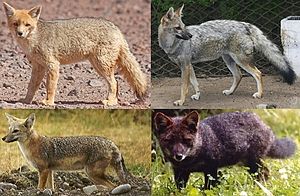남아메리카여우속
보이기
|
| ||
|---|---|---|
 왼쪽 상단: 칠레와 볼리비아 국경의 안데스여우, 왼쪽 하단: 남아메리카회색여우, 오른쪽 하단: 다윈여우 | ||
| 생물 분류ℹ️ | ||
| 계: | 동물계 | |
| 문: | 척삭동물문 | |
| 강: | 포유강 | |
| 목: | 식육목 | |
| 과: | 개과 | |
| 속: | 남아메리카여우속 (Lycalopex) Burmeister, 1854 | |
학명이명 | ||
|
Pseudalopex Burmeister, 1856 | ||
| 종 | ||
| ||
남아메리카여우속 또는 남미여우속(Lycalopex)은 개과에 속하는 포유류의 일종으로 남아메리카에서 발견된다. 이름은 남아메리카여우속이지만 전형적인 여우는 아니다. 그러나 독특한 개과 속으로 약간 여우를 닮았기 때문에 남아메리카여우속이라는 이름으로 불린다. 가장 흔한 종은 남아메리카회색여우로 큰 귀와 황갈색 술 장식의 모피로 잘 알려져 있으며, 모피는 시장에서 고가에 거래된다. 이 속 중에서 알려진 가장 오랜 화석은 칠레에서 발견되었고, 그 시기가 플리오세 중기부터 후기까지의 200~250만년 전까지 거슬러 올라간다.[2]
하위 종
[편집]현재 6종이 알려져 있다.[1]
- 회백색여우 또는 흰여우, 줄꼬리개 (Lycalopex vetulus)
- 다윈여우 (Lycalopex fulvipes)
- 팜파스여우 또는 아자라여우, 아자라조로 (Lycalopex gymnocercus)
- 남아메리카회색여우 또는 파타고니아여우, 칠라, 회색조로 (Lycalopex griseus)
- 페루사막여우 (Lycalopex sechurae)
- 안데스여우 또는 쿨페오 (Lycalopex culpaeus)
계통 분류
[편집]| 개과 |
| |||||||||||||||||||||||||||||||||||||||||||||||||||||||||||||||||||||||||||||||||||||||||||||||||||||||||||||||||||||||||||||||||||||||||||||||||||||||||||||||||||||||||||||||||||||||||||||||||||||||||||||||||||||||||||
각주
[편집]- ↑ 가 나 Wozencraft, W.C. (2005). “Order Carnivora” [식육목]. Wilson, D.E.; Reeder, D.M. Mammal Species of the World: A Taxonomic and Geographic Reference (영어) 3판. 존스 홉킨스 대학교 출판사. ISBN 978-0-8018-8221-0. OCLC 62265494.
- ↑ Lucherini, M. & Luengos Vidal, E. M. (2008). “Lycalopex gymnocercus (Carnivora: Canidae)”. 《Mammalian Species》: Number 820, pp. 1–9. doi:10.1644/820.1.
- ↑ Lindblad-Toh, Kerstin; Wade, Claire M; Mikkelsen, Tarjei S.; Karlsson, Elinor K.; Jaffe, David B.; Kamal, Michael; Clamp, Michele; Chang, Jean L.; Kulbokas, Edward J.; Zody, Michael C.; Mauceli, Evan; Xie, Xiaohui; Breen, Matthew; Wayne, Robert K.; Ostrander, Elaine A.; Ponting, Chris P.; Galibert, Francis; Smith, Douglas R.; Dejong, Pieter J.; Kirkness, Ewen; Alvarez, Pablo; Biagi, Tara; Brockman, William; Butler, Jonathan; Chin, Chee-Wye; Cook, April; Cuff, James; Daly, Mark J.; Decaprio, David; 외. (2005). “Genome sequence, comparative analysis and haplotype structure of the domestic dog”. 《Nature》 438 (7069): 803 in 803–19. doi:10.1038/nature04338. PMID 16341006.
- ↑ Nyakatura, K.; 외. (2012). “Updating the evolutionary history of Carnivora (Mammalia): a new species-level supertree complete with divergence time estimates”. 《BMC Biology》 10 (12). doi:10.1186/1741-7007-10-12.
- ↑ Koepfli, Klaus-Peter; Pollinger, John; Godinho, Raquel; Robinson, Jacqueline; Lea, Amanda; Hendricks, Sarah; Schweizer, Rena M.; Thalmann, Olaf; Silva, Pedro; Fan, Zhenxin; Yurchenko, Andrey A.; Dobrynin, Pavel; Makunin, Alexey; Cahill, James A.; Shapiro, Beth; Álvares, Francisco; Brito, José C.; Geffen, Eli; Leonard, Jennifer A.; Helgen, Kristofer M.; Johnson, Warren E.; o'Brien, Stephen J.; Van Valkenburgh, Blaire; Wayne, Robert K. (2015). “Genome-wide Evidence Reveals that African and Eurasian Golden Jackals Are Distinct Species”. 《Current Biology》 25 (16): 2158–65. doi:10.1016/j.cub.2015.06.060. PMID 26234211.
외부 링크
[편집] 위키생물종에 남아메리카여우속 관련 자료가 있습니다.
위키생물종에 남아메리카여우속 관련 자료가 있습니다. 위키미디어 공용에 남아메리카여우속 관련 미디어 분류가 있습니다.
위키미디어 공용에 남아메리카여우속 관련 미디어 분류가 있습니다.- Nowak, Ronald M. (2005). Walker's Carnivores of the World. Baltimore: Johns Hopkins Press. ISBN 0-8018-8032-7






























